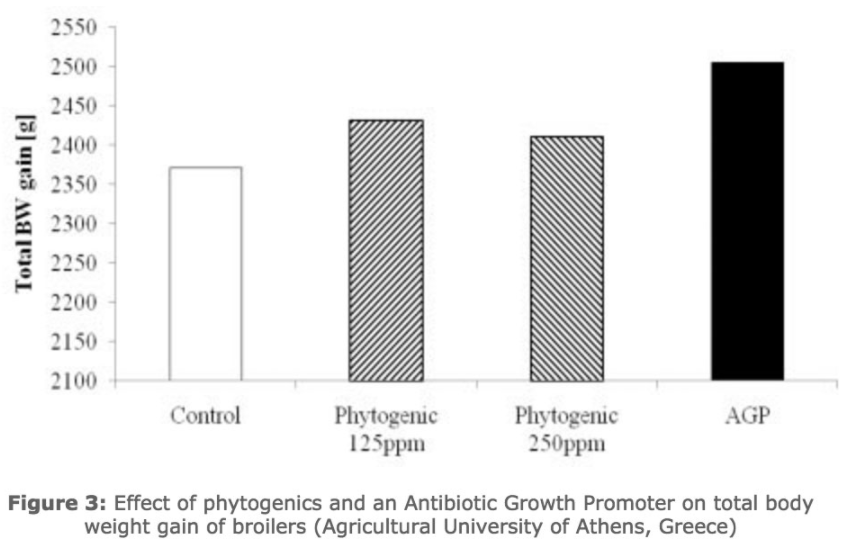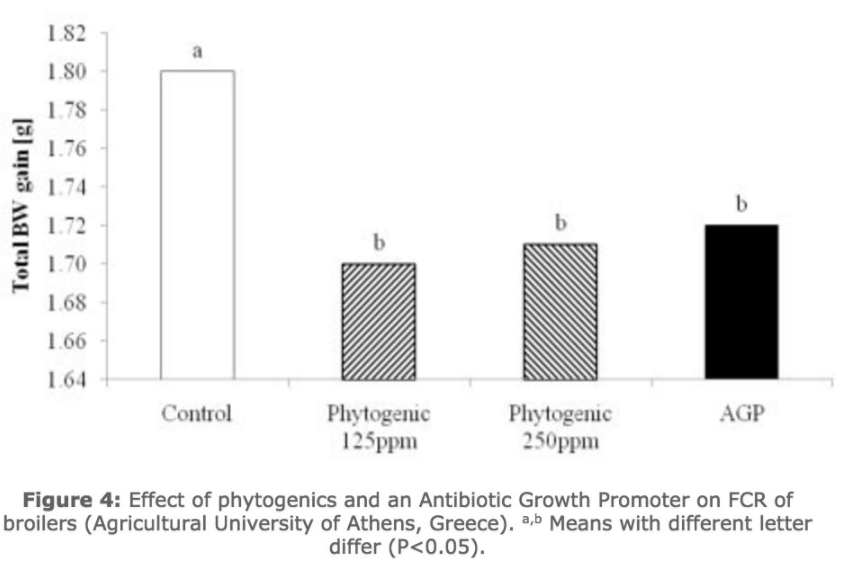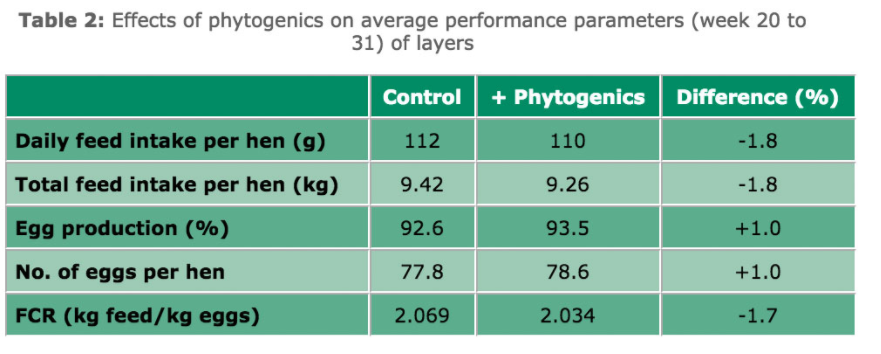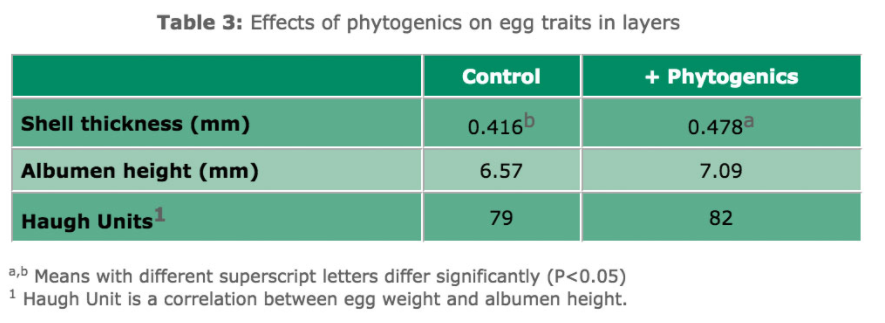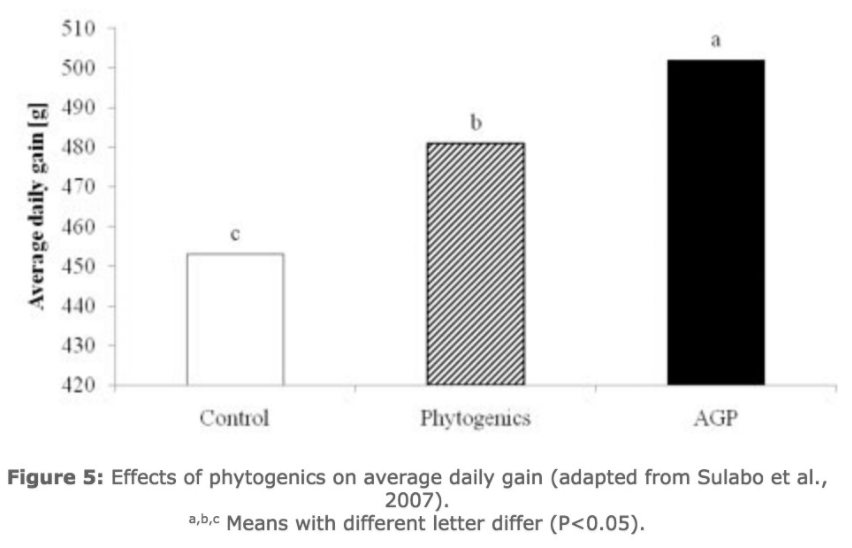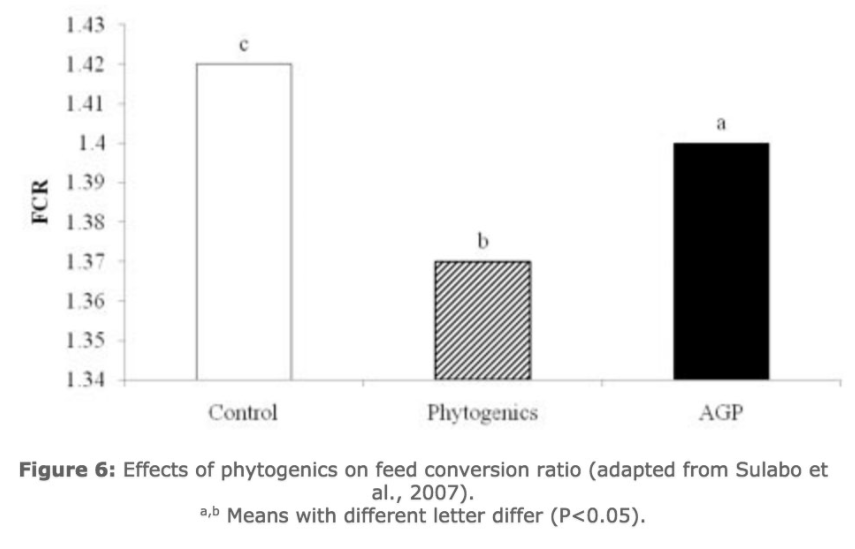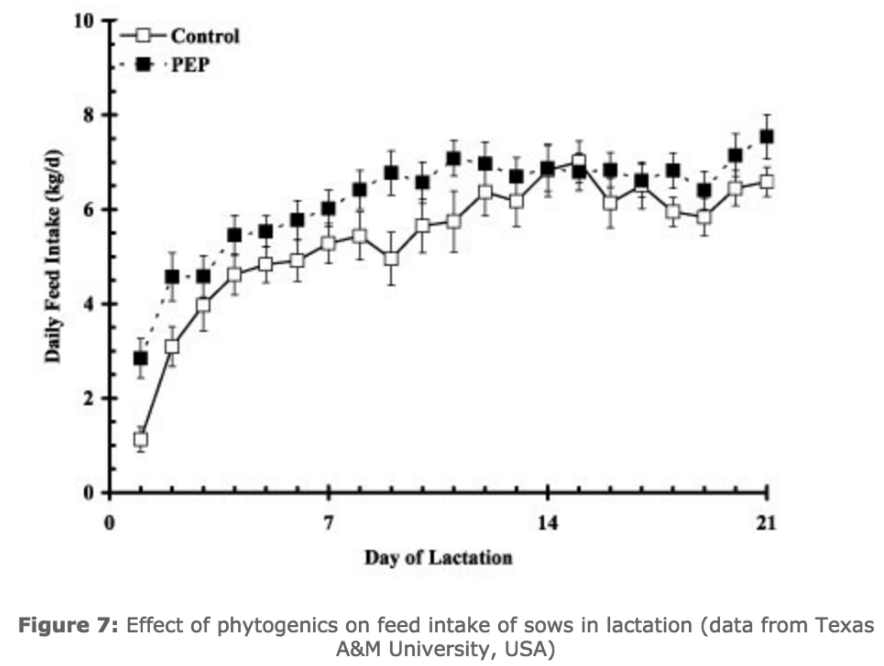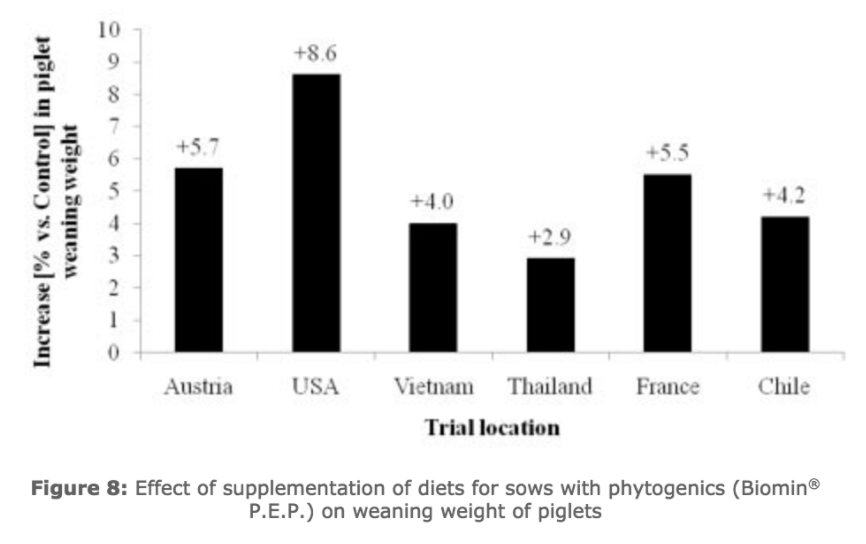



Optimising gut health and performance through a phytogenic feed additive
Phytogenic feed additives have gained considerable attention in the feed industry and to an increasing extent producers are incorporating them into their feeding programs. Today, 70–80% of the companies have been or are using phytogenics in broiler and pig feeds (World Poultry, 2008).Phytogenic compounds have traditionally been used as flavours and spices in human nutrition and medicine, as well as for food preservation. There are a large number of herbs and spices that may be considered as Natural Growth Promoters in animal nutrition, of which the most frequently used are presented in Table 1. Most of these plants contain a considerable number of active substances which determines their in vivo efficacy.
Table 1. Herbs and spices frequently used in phytogenic feed additives
It is evident that this category of feed additives covers a large variety of substances with an even bigger number of active ingredients, including carvacrol, thymol, cinnamaldehyde and anethol, just to mention a few important examples. Phytogenic feed additives are either available in a solid, dried and ground form or as extracts or essential oils. Usually, phytogenics vary seriously in their chemical ingredients, depending on their composition and influences of climatic conditions, locations or harvest time. Hence, differences in efficacy between phytogenic products which are currently available at the market can be attributed mainly to differences in their chemical composition (Steiner, 2006).
Essential oils are odoriferous, secondary plant products which contain most of the plant’s active substances, being mainly hydrocarbons (e.g. terpenes, sesquiterpenes), oxygenated compounds (e.g. alcohol, aldehydes, ketones) and a small percentage of non-volatile residues (e.g. paraffin, wax) (Losa, 2000). They are obtained from the raw materials, basically through steam distillation.
In comparison to Antibiotic Growth Promoters (AGPs), phytogenics do usually not bear the risk of cross-resistances and residues in animal products. Improvements in feed conversion ratio (FCR) and body weight gain, as well as their benefits in assisting in disease prevention have been observed in recent trials.
Mode of action of phytogenics
A vast number of studies have been carried out regarding the screening of phytogenic compounds for their biological activities. Several plant extracts have shown antimicrobial, anticoccidial, fungicidal or antioxidant properties associated with their lipophylic character (Giannenas et al., 2003; Helander et al., 1998; Juven et al., 1994). Phytogenic agents originating from oregano, thyme or cinnamon, for example, show broad antimicrobial activity against various pathogenic bacteria including E. coli, Salmonella and Clostridium. However, information about the mode of action of commercially available phytogenic feed additives is rather scarce. Assessment of biological effects is difficult if the composition of a test substance is unclear or variable. It is mandatory that phytogenic feed additives have a standardised composition which is based on carefully selected raw materials, undergoing strict quality control measures. A series of experiments was carried out using a synergistic combination of selected essential oils from oregano, anise and citrus, and prebiotic substances (Digestarom® P.E.P.).
Among these studies, recent data from a research project with swine (Kroismayr, 2008a,b) indicates that the mode of action of Digestarom® P.E.P. is versatile and conclusive (Figure 1), finally assisting the animal to reach its genetic potential for growth performance better.
Figure 1.Principal mode of action of a phytogenic additive based on oregano, anise and citrus essential oils (Digestarom® P.E.P.)
The study was initiated and lead by the University of Natural Resources and Applied Life Sciences, Vienna (Austria). Additionally, the University of Veterinary Medicine Vienna and the Technical University Munich–Weihenstephan (Germany) were involved in the project. Digestarom® P.E.P. was tested in weaning piglets because these animals, and especially their gut environment, are representative for many nonruminant species. One-hundred-and-twenty weaning piglets were assigned to three trial groups: (1) negative control group, (2) group with Digestarom® P.E.P. and (3) positive control group with a commonly used AGP (Avilamycin). On day 22 of the 50-day feeding trial, 12 piglets out of each trial group were sacrificed and samples of digesta and various tissues were collected. It was shown in this work that addition of the phytogenic feed additive to the basal diet resulted in a reduction of the total bacterial count in the intestinal tract, concomitant with an increased nutrient digestibility (Stoni et al., 2005, Figure 2). Furthermore, decreased contents of ammonia and biogenic amines were an additional indicator for the beneficial impact of the phytogenic feed additive on gut microbiology. Finally, a down-regulation of the immune system was observed, as indicated by smaller Peyers Patches in the ileum and lower activity of specific primers (NFκB, Cyclin D1) of immune action. In conclusion, this indicates that more energy and nutrients are available for accretion of body mass rather than for microbial growth and immune action (“energy and nutrient sparing”).
Figure 2. Effect of phytogenics (Digestarom® P.E.P.) on nutrient digestibility in pigs (after Stoni et al., 2005. a,b Means with different letter differ (P<0.05).
Furthermore, there is evidence that phytogenics stimulate digestive secretions such as saliva or endogenous digestive enzymes (Williams and Losa, 2001; Platel and Srinivasan, 1996). In the meantime, additional studies are in progress to further identify potential mechanisms associated with the incorporation of phytogenics in diets for different animal species.
Phytogenics in broiler production
The main target in broiler production is to optimise feed conversion (FCR). Digestarom® P.E.P. was tested in different dosages in a scientific trial at the Agricultural University of Athens, Greece (Mountzouris et al., 2008). Day-old, male Cobb broiler chicks were assigned to different treatments, comprising 3 replications per treatment and 105 birds per treatment. The Negative Control (NC) contained no growth promoters, whereas the Positive Control (PC) contained Avilamycin. In further treatments, Digestarom® P.E.P. 125 poultry was supplemented at 125 or 250 g/t, respectively. As shown in Figures 3 and 4, Digestarom® P.E.P. increased body weight gain and significantly improved FCR. Differences between the dosages of Digestarom® P.E.P. were minor, indicating that the regular inclusion level of 125 g/t was optimal under the experimental conditions herein.
Figure 3. Effect of phytogenics and an Antibiotic Growth Promoter on total body weight gain of broilers (Agricultural University of Athens, Greece)
Figure 4. Effect of phytogenics and an Antibiotic Growth Promoter on FCR of broilers (Agricultural University of Athens, Greece). a,b Means with different letter differ (P<0.05).
Phytogenics in egg production
The effects on performance and economics of Digestarom® P.E.P. were investigated in the early stages of the egg production cycle (Nichol and Steiner, 2008). A 12-week trial was carried out with high-performing, Lohmann Brown hens using six replications with 16 birds per replication in a randomized complete block design and resulting in 96 hens per treatment. The age of the birds at the beginning and conclusion of the trial was 20 and 32 weeks, respectively. The birds were assigned to two dietary treatments: (1) Control (no additives), (2) control + Digestarom® P.E.P. All birds were vaccinated for Newcastle Disease and Infectious Bronchitis every six weeks. As shown in Table 2, hens fed phytogenics consumed less feed and had higher egg production as compared to the control group. Total and average daily feed intake was lower by 1.8% when the control diet was supplemented with phytogenics.
Table 2. Effects of phytogenics on average performance parameters (week 20 to 31) of layers
Hens offered phytogenics produced more eggs and had a better feed conversion in comparison to birds in the control group. Additionally, supplementation of the diets with phytogenics improved egg shell parameters (Table 3), i.e. shell thickness (P<0.05) and albumen height. As indicated by a higher Haugh Unit rating (82 vs. 79), the internal egg quality was higher in hens fed phytogenics.
Table 3. Effects of phytogenics on egg traits in layers
Based on actual local prices, Digestarom® P.E.P. improved productivity, resulting in a 1.74% cost saving (47.09 vs. 47.74 USD per 1000 eggs).
Phytogenics and Necrotic Enteritis
Necrotic Enteritis (NE) is an extremely costly disease in modern broiler production. It was estimated that the cost related to NE in commercial broiler flock is as high as 5 US-cents per bird (Choct, 2006). The main causative agent of NE is Clostridium perfringens. C. perfringens is a gram-positive, anaerobic and spore-forming bacterium that is widely present in the environment. There are five types of C. perfringens (Type A, B, C, D and E), classified by their ability to produce different exotoxins (α-, β-, ε- and ι-toxin) as well as Clostridium perfringens Enteroxin. The severe disease pattern of NE is mainly related to α-toxin, a phospholipase which disintegrates cell membranes. Typical signs of NE are depressed growth performance and increased mortality, associated with severe lesions on the intestinal mucosa. It has been hypothesized that phytogenic agents might reduce the clinical signs of NE in broilers. A study conducted at the US Department of Agriculture (USDA) focused on this topic (Mc Reynolds et al., 2008). The results are very promising, showing that Digestarom® P.E.P. had a highly beneficial impact by reducing NE symptoms in birds that had been challenged with C. perfringens.
Phytogenics in pig nutrition
Optimising FCR is also crucial for efficiency in swine production. A trial was recently carried out at Kansas State University, United States, to evaluate the efficacy of phytogenics in comparison to AGPs in post-weaning piglets (Sulabo et al., 2007). 144 piglets (22 days of age) were assigned to three treatment groups: Group 1 was fed a negative control diet without growth-promoters. Group 2 received the negative control diet supplemented with Digestarom® P.E.P. Group 3 was offered a positive control diet containing AGPs (140 g/t neomycin sulfate and 140 g/t oxytetracycline HCl). Growth performance was significantly improved over the negative control group when phytogenics or antibiotics were added to the feed. In terms of average daily gains, the pigs fed phytogenics were intermediate between the negative control and the AGPs (Figure 5). Feed conversion, however, was best in the group receiving Digestarom® P.E.P. (Figure 6).
Figure 5. Effects of phytogenics on average daily gain (adapted from Sulabo et al., 2007). a,b,c Means with different letter differ (P<0.05).
Figure 6. Effects of phytogenics on feed conversion ratio (adapted from Sulabo et al., 2007). a,b Means with different letter differ (P<0.05).
Not only daily gain and FCR were improved by 5.2 and 4.5%, respectively. Also the Danish Production Value was increased by 10.3% through supplementation of the feed with phytogenics. The Danish Production Value represents an indicator of productivity and is calculated as follows: (kg gain × DKK/kg gain)–(no. of analyzed FUp × DKK/FUp), with figures being based on average local prices of 5 years.
Phytogenics in sow nutrition
The high energy requirement of the sow in lactation is compensated for by the reduction of body mass. A reduction in body mass by 15 kg is commonly considered as tolerable (Jeroch et al., 1999). However, higher reductions can negatively affect the sow’s fertility. There is a close correlation between litter size, feed intake and milk production, which indicates that feed intake of the sow has a substantial impact on litter performance. Sow’s milk is the primary source of energy, nutrients and antibodies for new-born piglets. Therefore, adequate lactation performance is crucial to obtain healthy piglets with satisfying growth rates. Data presented in Figure 7 was obtained from a trial at Texas A&M University, United States (Miller et al., 2003). In this trial, sows were fed either a basal feed with or without supplemental phytogenics. Sows fed Digestarom® P.E.P. consistently ingested more feed (on average 6.2 vs. 5.4 kg/d) as compared to the control sows. Furthermore, Digestarom® P.E.P. reduced sow body weight losses in lactation (7.2 vs. 13.3 kg) in the above mentioned study.
Figure 7. Effect of phytogenics on feed intake of sows in lactation (data from Texas A&M University, USA)
As a consequence of the increased sow feed intake in lactation, also piglet performance is usually substantially increased. The data from the Texas A&M University indicates the benefit of using Digestarom® P.E.P. in sows (Table 5).
Table 5. The effect of supplementation of sows with Digestarom® P.E.P. during late gestation through lactation on sow and pig performance (Miller et al., 2003)
As shown above, positive effects of phytogenics in sow nutrition are usually reflected in increased litter performance. Results from different trial locations are summarised in Figure 8. In these trials, supplementation of diets for sows with phytogenics (Digestarom® P.E.P.) increased average weaning weight of the piglets by 3 to 9%.
Figure 8. Effect of supplementation of diets for sows with phytogenics (Digestarom® P.E.P.) on weaning weight of piglets
Conclusion
Phytogenics represent one of the most promising groups of feed additives. It should be kept in mind that only a well-balanced and scientifically developed combination of active ingredients with defined properties can be expected to function synergistically in order to bring about the desired benefits for the producer. Consistent beneficial effects on productivity in poultry, pigs and calves have been reported in scientific studies using a blend of oregano, anise and citrus essential oils. Furthermore, an overwhelming portion of livestock producers consider phytogenics as an outstanding solution to enhance performance and, therefore, profitability.
References:
Giannenas, I., Florou-Paneri, P., Papazahariadou, M., Christaki, E., Botsoglou, N.A., Spais, A.B. (2003) Effect of dietary supplementation with oregano essential oil on performance of broilers after experimental infection with Eimeria tenella. Archives of Animal Nutrition 57, 99–106.
Helander, I.M., Alakomi, H.L., Latva-Kala, K., Mattila-Sandholm, T., Pol, I., Smid, E.J., Gorris, L.G.M., von Wright, A. (1998) Characterization of the action of selected essential oil components on Gram-negative bacteria. Journal of Agricultural and Food Chemistry 46, 3590–3595.
Jeroch, H., Drochner, W., Simon, O. (1999): Ernährung landwirtschaftlicher Nutztiere. Verlag Eugen Ulmer, Stuttgart, Germany.
Juven, B.J., Kanner, J., Schved, F., Weisslovicz, H. (1994) Factors that interact with the antibacterial action of thyme essential oil and its active constituents. Journal of Applied Bacteriology 76, 626–631.
Kroismayr A., Sehm J., Pfaffl M.W., Schedle K., Plitzner C., Windisch W. (2008a) Effects of Avilamycin and essential oils on mRNA expression of apoptotic and inflammatory markers and gut morphology of piglets. Czech J. Anim. Sci. 53, 377-387.
Kroismayr A., Schedle K., Sehm J., Pfaffl M.W., Plitzner C., Foissy H., Ettle T., Mayer H., Schreiner M., Windisch W. (2008b) Effects of antimicrobial feed additives on gut microbiology and blood parameters of weaned piglets. Die Bodenkultur. Bodenkultur 59: 111–120.
Losa, R. (2000) The use of essential oils in animal nutrition. 3rd Conference on Sow Feed Manufacturing in the Mediterranean Region. March 22–24, Reus, Spain, pp. 39–44.
Maribo, H. (2002) Test of Biomin® P.E.P. for weaners (Danske Slagterier Report no. 554). Available: www.danishpigproduction.dk/Research/Research_report/Nutrition_Weaners/Report_554.html.
Mc Reynolds , J.L., Byrd, J.A., Beltran R., Nisbet, D.J. (2008) Evaluation of probiotic and phytogenetic products on the development of Necrotic enteritis in poultry. 2008 International Poultry Scientific Forum, January 21–22, Atlanta, Georgia, p. 28.
Miller, J.A., Solis, L.A., Laurenz J.C. (2003) Enhancing feed intake during early lactation period in sows. Journal of Animal Science 81 (Suppl. 2), 14.
Mountzouris, K.C., Tsirtsikos, P., Paraskeyas, V., Fegeros, K. (2008) Evaluation of the effect of a phytogenic essential oils product on broiler performance and nutrient digestibility. XXIII. World Poultry Congress, June 30–July 4, Brisbane, Australia (submitted).
Nichol, R., Steiner, T. (2008) Efficacy of phytogenics in commercial Lohmann Brown layers. In: Feed Ingredients & Additives Asia Pacific Conference, March 5, 2008, Bangkok, Thailand.
Platel K., Srinivasan K. (1996). International Journal of Food Science and Nutrition 47, 55–59.
Steiner, T. (2006) Managing Gut Health - Natural Growth Promoters as a Key to Animal Performance. Nottingham University Press, Nottingham, United Kingdom.
Stoni, A., Zitterl-Eglseer, K. Kroismayr, A., Wetscherek, W., Windisch, W. (2005) 4. BOKU-Symposium Tierernährung: Tierernährung ohne Antibiotische Leistungsförderer. Vienna, Austria, pp. 147–153.
Sulabo, R.C., Yacela, J.Y., DeRouchey, J.M., Tokach, M.D., Neher, F., Goodband, R.D., Dritz, S.S., Nelssen, J.L. (2007) Effects of phytobiotics on nursery pig performance. Journal of Animal Science 85, Suppl. 1, 644.
Williams, P., Losa, R. (2001) The use of essential oils and their compounds in poultry nutrition. World Poultry 17, 14–15.
World Poultry (2008) Plant extracts popular in poultry. World Poultry 24(3), 9.










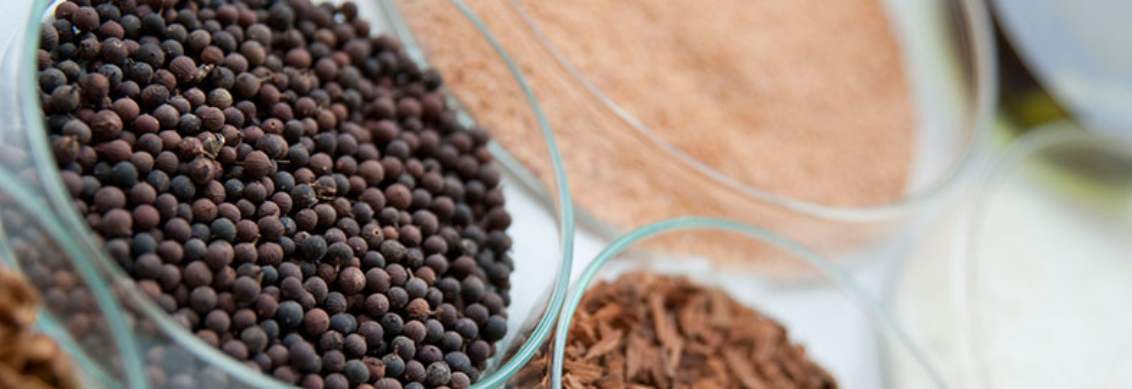
.PNG)


